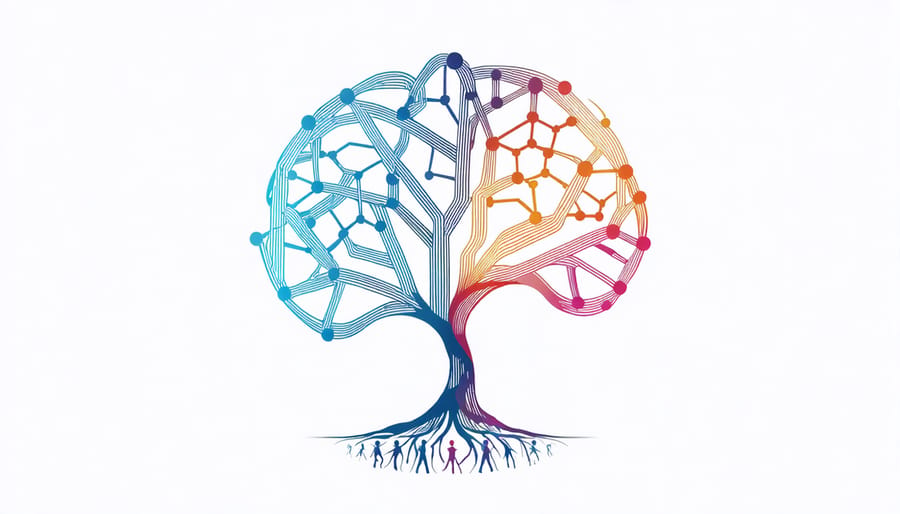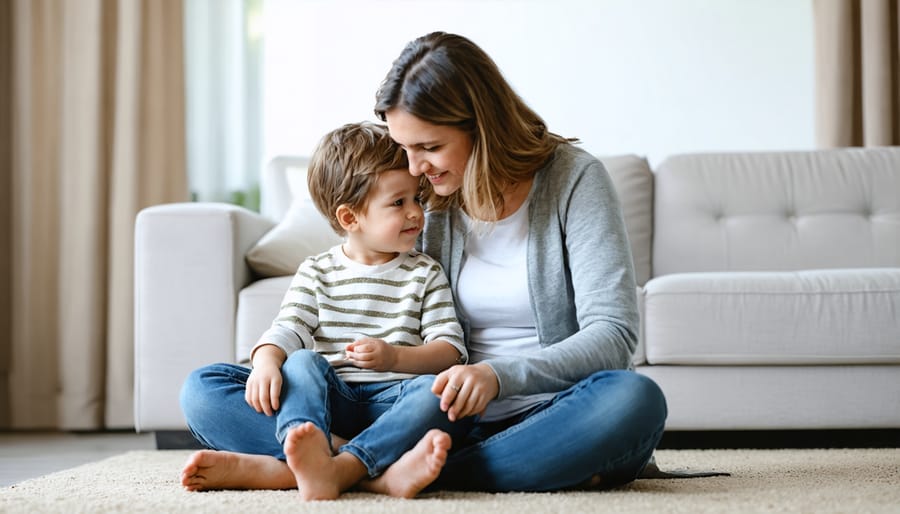Imagine a chain of invisible threads connecting generations – the whispered stories, unspoken traumas, and inherited strengths that shape our children’s mental health landscape. The intergenerational effect isn’t just about passing down eye color or musical talent; it’s about the profound ways our family histories influence our children’s emotional well-being, resilience, and mental health outcomes.
Recent research reveals that everything from anxiety patterns to coping mechanisms can echo through family trees, creating ripples that touch each new generation. But this inheritance isn’t our children’s destiny. Understanding these patterns offers us a powerful opportunity to transform family legacies and create healthier emotional foundations for our children.
What makes this journey particularly remarkable is that while we can’t change our past, we hold the power to reshape our children’s future. By recognizing these inherited patterns and actively working to heal generational wounds, we’re not just helping our children – we’re contributing to the emotional well-being of generations to come.
This awareness brings both responsibility and hope: responsibility to address our own healing, and hope in knowing that every step we take toward understanding and growth creates positive change that extends far beyond our immediate family circle.
Understanding Intergenerational Mental Health Effects

The Science Behind Family Mental Health Patterns
Mental health patterns in families stem from a complex interplay of genetic predisposition and environmental influences. Research shows that while certain mental health conditions can be inherited through our genes, our experiences and family dynamics play an equally significant role in shaping our emotional well-being.
Think of it like a garden – our genes are the seeds we inherit, but the environment we grow up in (our family’s emotional climate, parenting styles, and life experiences) determines how these seeds develop. For instance, a child might inherit a genetic tendency toward anxiety, but supportive parenting and healthy coping strategies can significantly influence how this tendency manifests.
Dr. Sarah Chen, a family therapist, explains, “What we’re learning is that even our genes can be influenced by our experiences through epigenetics – the way our environment affects how our genes are expressed.” This means that while we can’t change our genetic makeup, we can create environments that promote positive mental health outcomes.
Understanding these patterns empowers families to make informed choices about breaking negative cycles and fostering resilience across generations.
How Parental Mental Health Influences Children
Parents’ mental health significantly impacts their children’s emotional development and well-being in both direct and subtle ways. When parents struggle with anxiety, depression, or other mental health challenges, their ability to provide consistent emotional support and maintain stable routines may be affected. Children often pick up on their parents’ emotional states, even when adults try to hide their struggles.
For example, a mother experiencing depression might find it harder to engage in playful interactions or respond sensitively to her child’s needs. Similarly, a father dealing with anxiety might unknowingly transfer his worries to his children through overprotective behaviors or by modeling anxious responses to everyday situations.
These influences occur through various channels: genetic predisposition, learned behaviors, and environmental factors like family dynamics and stress levels at home. Children observe and internalize their parents’ coping mechanisms, emotional regulation strategies, and ways of viewing the world.
However, it’s important to remember that recognizing these influences is not about placing blame but understanding the connection to better support both parent and child mental health. With awareness and proper support, parents can work on their mental health while nurturing their children’s emotional well-being.
Common Intergenerational Mental Health Patterns
Anxiety and Depression Across Generations
Anxiety and depression often travel through family trees like an invisible thread, connecting generations through shared experiences and emotional patterns. Research shows that children of parents with anxiety or depression are more likely to develop similar mental health challenges, though this isn’t simply about genetics.
Sarah, a mother of two, shares her experience: “When I recognized my own anxiety patterns in my daughter, it was like looking in a mirror. But understanding this connection helped me break the cycle and get help for both of us.”
The transmission of anxiety and depression across generations happens through multiple pathways. Children learn emotional responses by observing their parents’ behaviors, coping mechanisms, and stress responses. Additionally, shared environmental factors, such as financial stress or family conflict, can impact multiple generations simultaneously.
However, this knowledge brings hope rather than despair. Dr. Lisa Martinez, a family therapist, explains, “Understanding these patterns allows families to intervene early and make positive changes. When parents work on their mental health, they’re not just helping themselves – they’re creating a healthier emotional environment for their children.”
Many families find that awareness becomes their first step toward change. By recognizing these patterns, parents can seek support, develop healthier coping strategies, and help their children build emotional resilience, effectively reshaping their family’s mental health trajectory for generations to come.
Trauma and Its Generational Impact
Trauma’s impact doesn’t end with the person who experiences it – it can echo through generations, affecting children, grandchildren, and even great-grandchildren. This phenomenon, known as intergenerational trauma, occurs through both environmental and biological mechanisms.
When parents carry unresolved trauma, it can influence their parenting style, emotional availability, and stress responses. For example, a mother who experienced childhood neglect might struggle to form secure attachments with her own children, despite her best intentions. Similarly, a father dealing with untreated anxiety might unknowingly pass on heightened stress responses to his children.
Recent research has revealed that trauma can actually influence gene expression through epigenetic changes, potentially affecting future generations’ stress responses and emotional regulation. Dr. Rachel Thompson, a leading trauma researcher, explains: “We’re discovering that the impact of severe stress and trauma can be passed down not just through learned behaviors, but through biological pathways as well.”
However, it’s crucial to understand that this inheritance isn’t destiny. With awareness, support, and proper intervention, families can break these cycles. Many parents who recognize these patterns in their lives have successfully created different experiences for their children, proving that healing is possible at any point in the generational timeline.
Breaking the Cycle
Recognizing Family Patterns
Understanding how mental health patterns run in your family starts with careful observation and documentation. Creating a family mental health timeline can reveal important connections across generations. Pay attention to recurring behaviors, emotional responses, and coping mechanisms that appear in multiple family members.
One effective tool is the family genogram – a detailed family tree that includes mental health information. While creating yours, look for toxic family patterns like communication styles, relationship dynamics, and responses to stress.
Consider keeping a journal to track:
– Behavioral similarities between family members
– Common emotional triggers
– Shared anxiety or depression symptoms
– Recurring relationship challenges
– Attitudes toward mental health care
Remember that recognizing these patterns isn’t about placing blame – it’s about understanding. Many parents find that simply becoming aware of these connections helps them make conscious choices to create positive change. If you notice concerning patterns, consider discussing them with a mental health professional who can help you develop strategies for breaking negative cycles.
Creating a Mentally Healthy Home Environment
Creating a mentally healthy home environment starts with understanding that small, consistent actions can make a significant difference in breaking intergenerational patterns. Begin by establishing predictable daily routines that provide children with a sense of security and stability. This might include regular mealtimes, consistent bedtime rituals, and dedicated family time.
Open communication is crucial. Create safe spaces for family members to express their feelings without judgment. Try implementing “feeling check-ins” during dinner or before bedtime, where everyone can share their emotional experiences of the day. Remember that building parental resilience is just as important as supporting your children’s emotional well-being.
Consider implementing mindfulness practices as a family. Simple activities like deep breathing exercises, nature walks, or quiet reading time can help reduce stress and anxiety. Create designated spaces in your home for relaxation and emotional regulation, such as a cozy reading corner or a calm-down area with soft pillows and sensory tools.
Set healthy boundaries while showing consistent love and support. This includes maintaining appropriate parent-child roles while being emotionally available. Celebrate small victories and progress rather than focusing solely on achievements, helping children develop a growth mindset and emotional resilience.
Remember to model healthy coping strategies. Children learn by example, so demonstrate self-care, emotional regulation, and positive stress management. When you make mistakes, use them as teaching moments to show that it’s okay to be imperfect and that learning from challenges is part of life’s journey.

When and How to Seek Professional Help
Recognizing when to seek professional help for intergenerational issues is crucial for family well-being. If you notice persistent patterns of anxiety, depression, or challenging behaviors in your children that mirror family history, it may be time to consult a mental health professional.
Consider reaching out when:
– Your child shows ongoing emotional or behavioral concerns
– You’re struggling to break negative parenting patterns
– Family relationships are consistently strained
– Past trauma affects your daily life or parenting
– You feel overwhelmed by your family history
Start by consulting your family doctor or pediatrician, who can provide referrals to appropriate specialists. Family therapists, child psychologists, and trauma-informed counselors are particularly skilled in addressing intergenerational concerns. Many communities offer sliding-scale fees or insurance-covered services to make therapy more accessible.
Look for professionals who:
– Have experience with family systems therapy
– Understand trauma-informed care
– Work with both children and adults
– Offer culturally sensitive support
– Provide evidence-based treatments
Remember, seeking help isn’t a sign of weakness but a step toward healing. Many parents find that working with a professional not only supports their children but also helps them process their own experiences. Early intervention can prevent the continuation of challenging patterns and create positive change for future generations.
Support groups for parents dealing with similar challenges can also provide valuable community connection and shared understanding while working with professionals.
Building Resilience in Children

Teaching Emotional Intelligence
Teaching children how to understand and manage emotions is crucial in breaking intergenerational patterns. Start by creating a safe space where children feel comfortable expressing their feelings without judgment. Use everyday moments to help them identify and label emotions – whether it’s excitement about a playground visit or frustration with a difficult puzzle.
Model emotional awareness by sharing your own feelings appropriately: “I’m feeling disappointed that our picnic got rained out, but we can make it special indoors instead.” This helps children understand that all emotions are valid and manageable.
Practice emotion coaching by acknowledging feelings before problem-solving. When your child is upset, try saying, “I see you’re angry because your brother took your toy. That must be really frustrating.” Then guide them through calming strategies like deep breathing or counting to ten.
Create emotional vocabulary through storytelling and play. Use stuffed animals or dolls to act out scenarios and discuss different feelings. Books about emotions can also provide excellent conversation starters and help children recognize that others experience similar feelings.
Remember, emotional intelligence develops gradually. Celebrate small victories and maintain patience as your child learns these essential life skills.
Developing Healthy Coping Skills
Building healthy coping skills is essential for children affected by intergenerational patterns. Start by creating a safe emotional environment where children feel comfortable expressing their feelings. Encourage open dialogue about emotions through activities like drawing, storytelling, or playing together.
Teaching mindfulness techniques can help children manage stress effectively. Simple breathing exercises, guided imagery, or quiet time for reflection can become valuable tools they carry into adulthood. For younger children, these practices can be introduced through games or playful activities.
Physical activities like sports, dance, or yoga provide healthy outlets for emotional expression and stress relief. Creative pursuits such as art, music, or writing also offer powerful ways for children to process their feelings and build self-awareness.
Help children identify their support network – trusted adults, friends, or mentors they can turn to when feeling overwhelmed. Role-playing different challenging scenarios can help them practice healthy responses to stress and difficult emotions.
Remember that developing coping skills takes time and patience. Celebrate small victories and maintain consistency in supporting these practices. As Dr. Sarah Chen, child psychologist, notes, “When we help children build strong coping skills early in life, we’re giving them tools that can break negative cycles and create positive patterns for generations to come.”
Understanding intergenerational effects can be eye-opening, but it’s essential to remember that knowledge is power. Breaking negative cycles isn’t just possible – it happens every day in families around the world. With awareness, support, and dedication, parents can create new patterns that foster positive mental health for future generations.
Remember that seeking help isn’t a sign of weakness but rather an act of courage and love for your children. Every small step toward better mental health – whether it’s attending therapy, learning new parenting strategies, or working on personal growth – creates ripples of positive change that benefit the entire family.
Many parents who’ve faced their own childhood challenges have successfully created nurturing environments for their children. Through conscious parenting, building strong support networks, and accessing professional resources when needed, they’ve transformed their family’s story.
You have the power to write a new chapter in your family’s history. The cycle of intergenerational trauma can end with you, making way for a legacy of resilience, emotional well-being, and healthy relationships that will benefit generations to come.







